
Collision Pros Magazine 2018 | ISSUE 3
The Genuine Advantage
WHY GENUINE TOYOTA PARTS SUPERIOR TO THE AFTERMARKET
Aftermarket parts exist alongside Original Equipment (OE) parts. At first glance, you may not see a difference between the two, and your customer may think they’re getting the real thing when they’re not. The fact is, the majority of your customers rely on your expertise and advice. Therefore, it’s up to you to ensure that they understand why Genuine Toyota Parts are the best choice when it comes to restoring their vehicle to pre-loss condition.
DESIGN, FIT AND PRICE
Genuine Toyota Parts are guaranteed to fit right the first time, where aftermarket parts often require additional installation time. Further, they’re engineered to meet all applicable federal regulations required when the vehicle was produced—including crash, emissions and fuel economy standards. Another important distinction: Genuine Toyota Parts are tailored for each vehicle, whereas an aftermarket manufacturer may have one design for a radiator tank and make that tank work for everything from a Prius to a Tundra. Additionally, when an aftermarket company puts their name on a part, you have no idea who actually manufactured that part or what the quality standards are from one part to the next.
When your technicians don’t have to spend extra time to make an aftermarket part fit, you can keep your labor costs in line with your quote. Along these lines, it’s important to note that insurance companies often give you a set amount of time to perform the repair. If an aftermarket part requires more time to install, that may negatively affect your standing with that insurance company and ultimately your customer. Additionally, Toyota OE parts are competitively priced with aftermarket parts, they’re a wise financial choice and the best parts for your customer’s Toyota.
PROVEN PERFORMANCE
Genuine Toyota Parts are rigorously tested to ensure they fit and perform like the original parts on the vehicle. They have been confirmed to work properly under a wide variety of driving conditions, from extreme heat, bitter cold and rough terrain to endurance driving and extensive stopping and starting. The same cannot be said for aftermarket parts. Finally, you and your customers get peace of mind with Toyota’s warranty—we stand behind every part we make.
RIGOROUS PRODUCT TESTING
For example, Genuine Toyota radiators and condensers are engineered to deliver the ideal cooling capabilities for each specific vehicle application and engine. Below is an example of the types of tests these two products must pass for peak performance under extreme conditions. Can the aftermarket product claim the same testing?
Genuine Radiator tests include:
- Radiation Rate Ventilation Resistance
- Passage Resistance
- Airtightness
- Pressure Resistance
- Corrosion
- Vibration
Genuine Condensers must also pass a series of exhaustive tests:
- Heat Radiation Performance / Air Flow Restriction / Flow Path Resistance
- Residual Foreign Substance
- Tube Strength
- Pressure Resistance
- Repeated Pressurization
- Corrosion Resistance Dewing
- Vibration
THE BAKER GRADE
The Genuine Toyota Radiator and Condenser Product Line is subjected to simulated Baker Grade testing. In just 19 miles the Baker elevation increases 3000 feet with ambient temperatures exceeding 100 degrees. In addition to the grueling elevation change, the maximum passenger and towing payload is added (for example, a Tundra Crew Max towing a trailer).
THE BOTTOM LINE
Using aftermarket parts rather than Genuine Toyota Parts can be costly in the long run. The reality of installing an aftermarket part is that it may not fit right the first time and may not be manufactured to the same standards, and that may compromise the quality, durability and safety of the vehicle. All of this can lead to customer dissatisfaction. Studies have shown that customers will switch brands after only one bad experience. Your customers demand quality. Give it to them by relying on Genuine Toyota Parts for all of your repairs.
CONSIDER GENUINE TOYOTA RADIATORS ADDED VALUE
Genuine Toyota Parts
Also known as OE parts (for Original Equipment). Genuine Toyota Parts are made for or by Toyota and must adhere to Toyota’s technical specifications as well as Toyota’s strict manufacturing and quality standards.
VS
Aftermarket Parts
Any part made for a vehicle that is not manufactured using OE specifications. Aftermarket parts are frequently developed by copying the original part, also known as “reverse engineering”. These parts may not perform the same as parts manufactured following Toyota specifications.
RADIATOR TANKS
Specific thermoplastic materials are used to:
- Ensure uniform flow during the manufacturing process resulting in consistent tank thickness and shape, and accurate mounting and plumbing features (i.e., inlet and outlet)
- Provide long-term durability due to high fluid temperatures and heat radiated from the engine
- Manufactured to uniform thickness and molded to help ensure optimal performance. If the thickness of the tank is too thin overall, or in one spot, it could result in a failed parts
HEADER PLATES
- Engineered and precision stamped to provide secure mating with the core, which ensures dependable long-lasting performance.
RADIATOR TANK GASKET
- Unique rubber material used to ensure high durability due to temperature cycling.
MOUNTING POINTS
- Multi-point comparison to OE product and vehicles to ensure fit.
ATTACHMENT POINTS
- The attachment points are guaranteed to be in the correct spot.
BRACKETS
- Brackets line up and bolt in for easy installation.
RECEIVER DRYER
- Includes the same size desiccant bag as the OE equivalent.
TUBES AND FINS
- Tube design and material selection optimize coolant flow allowing for efficient heat transfer to fins.
- Fin pitch and louver design create an optimal balance between air flow and heat transfer.
- Stronger tubes designed to withstand impact from road debris.
CONDENSER TANK
- Thick aluminum tanks are engineered to sustain a highly pressurized system.



